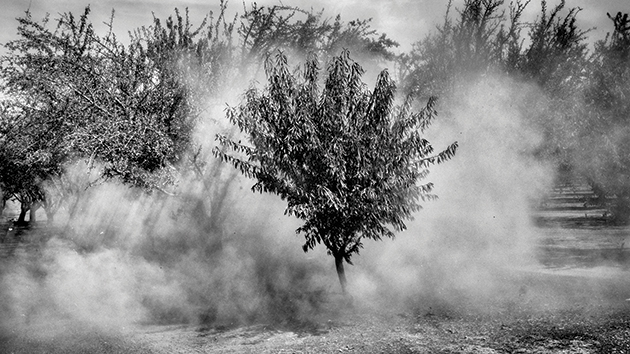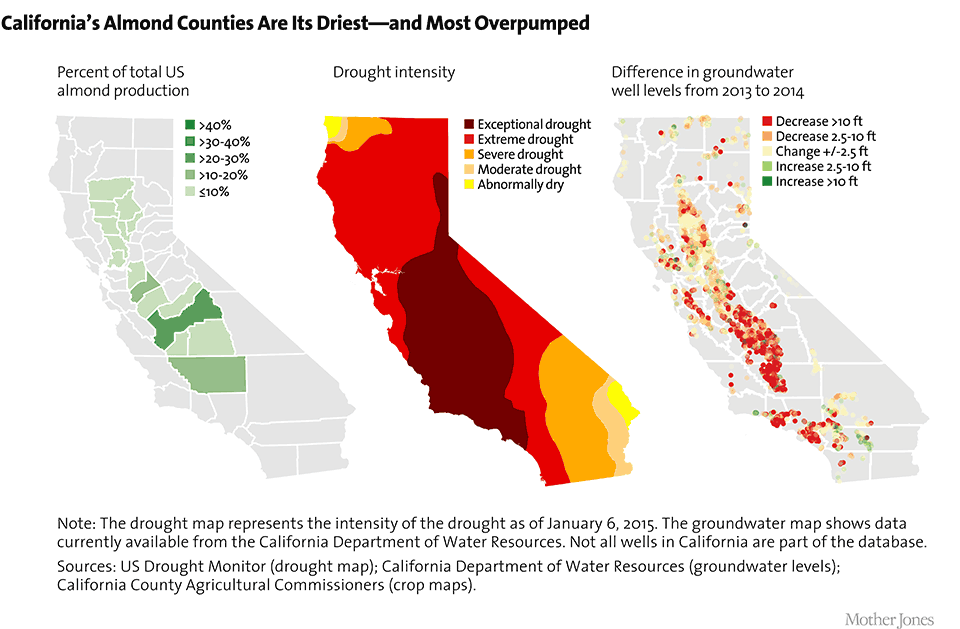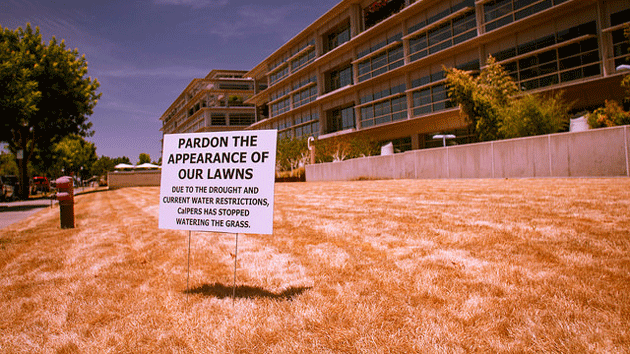
On a sunbaked August morning, off a rural road in the heart of California’s Central Valley, a low-slung tractor rumbles between neat rows of identical, light-green trees. To its right, a plume of dust billows up, thick enough to blot out the sky above the treetops. A chute on the truck sends a steady stream of almonds flying into the trailer hitched behind.
Sweating as I skitter around to avoid the moving tractor, I’m witnessing what has emerged as one of the Central Valley’s most lucrative rituals: the almond harvest. Here in western Fresno County, which generates more than a fifth of California’s almonds, production has more than doubled since 2005. Almonds are now nearly as valuable as the state’s vaunted grape harvest.

Another truck has already been through the orchard, armed with a giant metal forceps that grabs each tree trunk and shakes it violently for a few seconds, sending nuts clattering to the ground like a slow-moving hailstorm. Next, sweepers come through, mounding the almonds into long, narrow piles along the center of each row. Last comes the harvester to hoover them up.
The pale, sandy soil is bone-dry—hence all the dust. But that has nothing to do with the drought that is gripping California, the region’s worst in decades. The San Joaquin Valley, which forms the southern half of the 450-mile-long Central Valley, is technically a desert: In good years, it relies on irrigation water guided in from mountain ranges to the north and east through an impressive system of channels. And in the weeks before a harvest, almond farmers cut way back on watering, both to hasten the ripening of the nuts and to ensure a dry bed for them when they fall. The harvest is a notoriously hot, dusty affair.

As I gape at the efficiency on display—just a few workers and machines can harvest thousands of trees in several hours—an angry voice cuts through the truck’s roar. “Hey!” It’s a guy who looks to be in his 20s, slender, in a dusty baseball cap, a plaid shirt, and jeans. He says he’s heard from my travel companions—a photographer and an almond specialist from the University of California Cooperative Extension named Gurreet Brar—that I’m a magazine writer looking into California’s almond boom. He demands to know what my angle is. Am I going to blame almonds for the state’s mounting water woes, like other articles have?
When I assure him I’m after the whole story, he softens. He declines to give his name or be interviewed at length, but says his family farms almonds, apricots, and raisin grapes. Now they’re pulling the grapes to put in more almonds—raisins, he explains, aren’t a very well-marketed crop, so it’s harder to make a profit. And with that, he excuses himself to go manage the harvest.

His logic is unassailable. Almond products—snack mixes, butters, milk—are flying off supermarket shelves. The value of the California almond market hit $4.8 billion in 2012—that’s triple the level of a decade earlier. Only dairy is worth more to the state than almonds and grapes. In fact, almonds, along with California-grown pistachios and walnuts, are becoming so lucrative that big investment funds, eager to get in on the boom, are snapping up land and dropping in trees.
There’s just one problem: Almond orchards require about a third more water per acre than grape vineyards. In fact, they’re one of California’s thirstiest crops. It takes a gallon of water to produce a single almond—more than three times the amount required for a grape and two and a half times as much for a strawberry. There’s more water embedded in just four almonds than there is in a full head of lettuce. But unlike row crops, which farmers can choose not to plant during dry spells, almond trees must be watered no matter what.
In the midst of the worst drought in California’s history, you might expect almonds’ extreme thirst to be a deal breaker. But it’s not. In fact, the drought has had hardly any impact at all on the almond boom. The state’s farmers bought at least 8.33 million young almond trees between July 2013 and July 2014, a 25 percent increase from the previous year. About a quarter of the saplings went to replace old orchards, but most of the rest were new plantings, some 48,000 acres’ worth, an area equal to three Manhattans.

In order to thrive, almond trees need a Mediterranean climate, hot summers and mild winters. Those come free in the Central Valley. But steady access to water is just as crucial to an almond grove’s success. So where is the water for all these new orchards coming from? No longer California’s famed irrigation projects, which draw on the state’s rivers and have slowed to a trickle during the drought. Instead, farmers are tapping into groundwater.

In all of the other water-scarce states in the West, authorities restrict how much water a user can pump out of the ground. But in California, landowners can drop a well wherever they want, unimpeded by the state. Some counties require permits for wells (though they’re usually easy to get), and in a few Central Valley watersheds, things have gotten so contentious that courts have stepped in to limit water pumping. But mostly, California groundwater is yours for the taking. As the State Water Resources Control Board puts it on its website, “To get a right to groundwater, you simply extract the water and use it for a beneficial purpose.”

As a result, Central Valley farmers have for years been drawing down groundwater at an alarming rate. Between 2003 and 2010, the valley’s aquifers lost a total of 20 cubic kilometers of groundwater—enough to meet the household water needs of New York City for 11 years.
And then came the current drought, which started in 2011, when suddenly the region’s groundwater was being pumped up at an estimated rate of nearly seven cubic kilometers per year. That’s the same amount of water that everyone in Texas uses at home annually. Jay Famiglietti, a senior water scientist at NASA’s Jet Propulsion Laboratory who tracks groundwater depletion, points out that no one knows exactly how much water is left in the region’s aquifers—mainly because the state’s lax regulation means no one keeps track—but the current depletion rate has pushed the state “to the edge of a cliff,” he recently wrote. Meanwhile, several recent studies suggest that the West is actually in the early stages of a multidecade “megadrought.”
Experts worry that the combination of overpumping and drought could be catastrophic for the Central Valley, whose economy depends on being one of the world’s most productive farming areas. Richard Howitt, an agricultural economist at the University of California-Davis Center for Watershed Sciences, told me that he considers the situation “a slow-moving train wreck.”
You may think of almonds as the crunchy joy in your candy bar, the protein blast in your cereal. But to Wall Street, they have emerged as a white-hot global commodity—spawning a mini-gold-rush for the Central Valley, where more than 80 percent of the world’s almonds, as well as increasing percentages of pistachios and walnuts (43 percent and 28 percent, respectively), are grown.
Low in carbohydrates and high in monounsaturated fat and protein, these nuts are buoyed by a rising wave of nutritional consensus and diet fads (gluten-free, paleo, low-carb, etc.). In the United States, per capita almond consumption has jumped 225 percent since 2005—hitting two pounds per year and surpassing peanuts as America’s favorite nut. (Yes, botany sticklers, neither peanuts nor almonds are technically nuts; the former are legumes and the latter the seeds of drupes.) WhiteWave Foods (owner of the Silk brand) reports that US sales of its almond milk leapt 52 percent in the first quarter of 2014 compared to the previous year. Almond milk now makes up about two-thirds of the company’s total US faux-milk sales, trouncing even soy.

Our increasing fondness for nuts—along with a $28-million-a-year marketing campaign by the Almond Board of California—are part of what has prompted the almond boom. But the main driver comes from abroad. Nearly 70 percent of California’s almond crop is exported, with China the leading customer: Between 2007 and 2013, US almond exports to China and Hong Kong more than quadrupled, feeding a growing middle class’ appetite for high-protein, healthy food. Almonds now rank as the No. 1 US specialty crop export, beating wine by a count of $3.4 billion to $1.3 billion in 2012. (Walnuts and pistachios hold the third and fourth spots, each bringing in more than $1 billion in foreign sales.) As a result, wholesale almond prices jumped 78 percent between 2008 and 2012, even as production expanded 16 percent.
According to UC-Davis’ Howitt, the shift to almonds and other tree nuts is part of a long-term trend in California, the nation’s top agricultural state. Farmers in the Central Valley once grew mostly wheat and cattle. But over time, they have gravitated toward more-lucrative crops that take advantage of the region’s rare climate. “It’s a normal, natural process driven by market demand,” Howitt says. “We grow the stuff that people buy more of when they have more money.” Like nuts, which can replace low-margin products such as cotton, corn, or beef.
Family farms are reaping part of the almond windfall: According to the Almond Board of California, 72 percent of the state’s 6,500 almond farms are owned by families, and half are smaller than 50 acres. But massive financial interests—banks, pension funds, investment arms of insurance companies—are moving rapidly into the nut trade. Take TIAA-CREF, a New York-based retirement and investment fund with nearly a half-trillion dollars in total assets under management. The firm, which owns 37,000 acres of California farmland, claims to be one of the globe’s top five almond producers. On its website, TIAA-CREF says its California holdings produce more than 18 million pounds of almonds, or “enough to circle the world more than nine times.” In a report last year, the firm had one word for investors: nuts. It cited the rise of the nut-hungry Asian middle class and a global land base that’s “vanishing” because of urban sprawl, water scarcity, and environmental degradation. Almond orchards, said TIAA-CREF, were an “attractive long-term investment theme” with the potential to combine the steady income of bonds with the growth potential of stocks—a kind of investor’s holy grail.
Then there’s Hancock Agricultural Investment Group, a subsidiary of the sprawling Canadian insurance and financial services giant Manulife Financial. It manages $2.1 billion worth of farmland, mainly for large institutional investors like pension funds. Individuals can buy in—for a minimum investment of $5 million. HAIG owns at least 24,000 acres of almonds, pistachios, and walnuts, making it California’s second-largest nut grower. In a recent report to investors, HAIG reported that its nut holdings delivered more than 30 percent in total return (income from crop sales plus land appreciation) in 2013, far outpacing gains from its other crops like wine grapes, apples, cranberries, corn, and soybeans.

But the largest California nut grower of all is neither an insurance conglomerate nor (exactly) a family operation. Paramount Farms, owned by the Beverly Hills magnates Stewart and Lynda Resnick, has more than 70,000 acres of almonds and pistachios, and claims on its website to be the “world’s largest vertically integrated supplier” of those commodities, meaning that its operations control (and capture profits from) all the phases of production, from growing to processing and marketing. The power couple has also been adept at ensuring their nut and pomegranate plantations get plenty of surface water: They store it for dry years in the Kern Water Bank, a man-made, underground reservoir built by the state of California for public water storage. In an infamous deal in 1994, the Resnicks’ holding company gained a controlling interest in the water bank, making their nut groves less directly reliant on groundwater. Meanwhile, they’ve ramped up their campaign donations at the federal level, where lawmakers have a say in how much surface water—which, unlike groundwater, is highly regulated by both the federal and state governments—makes it into the Kern bank.
Having previously turned island water (Fiji) and pomegranate juice (Pom Wonderful) into ubiquitous products—and amassed a $3.8 billion fortune—the Resnicks have more recently turned their attention to pistachios, hiring the Korean rapper Psy and Stephen Colbert (“They’re wonderful. I’m wonderful…I think we’re done”) to pitch their Wonderful Pistachios brand.
According to Howitt, the flow of big money into almonds is a “rational response” to two broad economic factors: low interest rates, which make safe investments like bonds unattractive, and that ever-rising demand from China.
All summer long, the Central Valley is baking hot (100-plus-degree days are common) and dry as dust. Yet the valley ranks as one of the globe’s most productive farm landscapes, accounting for a third of US-grown fruits and vegetables. Making it bloom requires moving titanic amounts of water, mostly from snowmelt flowing down from the eastern mountain ranges and into California’s elaborate network of canals and aqueducts. Of this total—what the state refers to as “developed” water—agriculture uses about 80 percent, and almond groves suck up nearly 9 percent of that. That’s more than enough water, notes Carolee Krieger of the California Water Impact Network, to supply the yearly household needs of greater Los Angeles, San Diego, and the San Francisco Bay Area combined—around two-thirds of California’s population.
Even in good precipitation years, California agriculture has gotten so ravenous for surface water that the Sacramento-San Joaquin River Delta, a critical engine of coastal biodiversity, stands at the edge of biological collapse. The state’s once-prolific salmon run, which depends on water making it all the way to the ocean, barely persists; more than 90 percent of marshes have been drained.
And when droughts hit, there’s not enough water to divert to agriculture either: Two major canal-and-pipeline systems that move water from the mountains to farmland—the federally run Central Valley Project and the California-run State Water Project—cut farmers off entirely for several months this year. While farmers can forgo annual crops like tomatoes and melons during droughts, failing to irrigate trees means losing the entire orchard. That leaves many nut and fruit farmers with only one option: groundwater. A recent UC-Davis study estimated that in the 2014 growing season, pumped-up groundwater will replace as much as 75 percent of the surface water that went missing due to the drought.
There’s a financial metaphor that helps to explain California’s dilemma. To live off surface water is to live off your paycheck. To rely on groundwater is to tap into your 401(k). Every draft you take is one that you won’t be able to replenish, at least not easily.
The water-drilling frenzy is worst in the San Joaquin Valley, which contains the great bulk of California’s almond and pistachio production. In most San Joaquin counties, the number of well permits nearly doubled between 2011 and 2013, an analysis of county records by the San Jose Mercury News found. This region is home to the epicenter of California’s nut juggernaut—Kern, Fresno, and Tulare counties, together known as the Tulare Basin. Kern and Fresno counties are by a wide margin the state’s leading almond producers, churning out 43 percent of California’s total harvest, or about one of every three almonds consumed on Earth.

The Almond Board of California likes to point out that almond production has become considerably less water-intensive as farmers have turned to drip irrigation and other methods for squeezing more crop from each drop. Gurreet Brar, the University of California Cooperative Extension almond specialist, tells me that the amount of water it takes to produce a pound of almonds has fallen by a third since 1990. But amped-up production has more than offset efficiency gains. As recently as 1995, California orchards were cranking out 370 million pounds of almonds a year. In 2013, they produced 2 billion pounds—a five-and-a-half-fold increase. Today, 80 percent of almonds consumed around the world, and about 40 percent of pistachios, come from California.
And land devoted to almonds just keeps growing, expanding by 20 percent between 2007 and 2013 and now reaching 940,000 acres, an area larger than Rhode Island. Pistachios are spreading at an even faster clip. Between 2005 and 2012, pistachio acreage jumped 75 percent.
Last summer, as orchards grew, the drought persisted, and the water tables dropped, the panicked California Legislature finally did something that agriculture interests had successfully fought back for a century: It took a baby step in the direction of groundwater regulation. Legislation passed in September orders the state’s watershed districts to create a framework for regulating groundwater—but the rules don’t go into effect for six years, and no one knows yet how effective they will be. They could take decades to make a difference, and they are still weaker than those of other Western states—for example, they don’t require a permitting process for new wells. Still, some farm groups—California’s Agricultural Council and Farm Bureau, along with nut growers and processors—were outraged by the new legislation and lobbied against it.
The day after my trip to Fresno, I’m making my way down dirt roads alongside irrigation ditches, into a stand of new pistachio trees planted in neat, monotonous rows nearly to the horizon: some nine square miles of scrawny saplings, connected by drip irrigation tubes. It’s like Iowa’s endless cornfields, but with nuts.
Deep inside the orchard, I come upon a three-man crew working on a massive well. A red crane towers 30 or so feet into the sky next to a stack of 20-foot metal pipes. The crew shoos us back, but my guide for the day, John Burchard, the soft-spoken, energetic octogenarian who manages the local municipal water supply, can tell they’re deepening a well.
A lanky man in dark dungarees, a long-sleeved blue work shirt, and a brown felt cowboy hat turned up sharply at the sides, Burchard has friendly eyes and a neatly trimmed white goatee. It’s his job to deliver safe water to the 1,026 residents of Alpaugh, a hardscrabble farmworker town in the heart of the parched Tulare Basin. Tulare County granted 831 well permits in 2013—more than any other county in the San Joaquin Valley, and twice as many as in 2011.
Alpaugh was once rich in water—in fact, it was an island, sitting in the middle of Tulare Lake, the biggest freshwater lake west of the Mississippi River before it was drained in the early 20th century to feed irrigation projects. Ever since, the lake-bottom land around it has been fertile farm country.

But these days, things are dire. Under a morning sun still cranking up to full fire, Burchard shows me one of the town’s two active wells. For years, Alpaugh got its tap water from here. But as the drought dragged on, Burchard found the water table dropping a stunning 10 feet per week. By May, the well became inoperable. “If we kept using it, we’d soon be pumping air,” he says.
So he had to switch to the town’s other well, which is 100 feet deeper. It taps a different part of the aquifer with higher levels of naturally occurring arsenic. Burchard’s first well was barely compliant with the EPA’s arsenic limit, 10 parts per billion. The water from the deeper well had 30 parts per billion.
Chronic low-level exposure to arsenic has been linked to heart disease and cancer; children and fetuses are particularly vulnerable. When the water from Burchard’s second well hit Alpaugh’s taps, the town warned residents about the arsenic. They now rely on bottled water, spending roughly $1,200 annually per household, or $400,000 for all residents put together—a huge burden in a town largely made up of low-wage farmworkers. “That’s more than our total budget,” says Burchard, noting that the entire town government has about $300,000 to spend on water. With an extra $400,000, Burchard says, he could filter out the arsenic—”I could send rose water” through the taps.
Across the valley, the pumping frenzy is causing severe strains. Jessi Snyder, a community development specialist with Central Valley-based Self-Help Enterprises, says that several other towns in Tulare County struggle with similar arsenic issues. More than 300 residents of East Porterville saw their wells simply dry up last August, forcing the county to send in emergency bottled-water rations.
Meanwhile, under a recent decree from Gov. Jerry Brown, Burchard says he has to impose “severe” water use restrictions on Alpaugh’s residents, as part of a statewide effort to combat the drought. People who already can’t drink the water will now face tough rules on when they can water their lawns and gardens. As he explains what he calls this “bitter irony,” I look around at the town’s low-slung modest houses with their small yards supporting patches of grass and the occasional fruit tree. Peach trees that supply fresh fruit to cash-strapped families face water restrictions while the vast nut orchards around them thrive. Of course, any water savings Burchard manages to wring out of residents will amount to a rounding error compared to the water going to agriculture. In his irrigation district, just 2 percent of water goes to homes. The other 98 percent goes to farms.

When will California’s nut boom end? Might some other country—say, China—just step in and put down massive plantings? Doubtful, says David Doll, an orchard adviser with the University of California Cooperative Extension. No other region has California’s combination of land, climate, infrastructure, and research support to supplant it as the globe’s almond king. “India and China have tried, and failed,” he says.
But an ongoing almond boom will bear ecological costs along with vast profits. As the water table drops from overpumping, the remaining water picks up higher concentrations of minerals from deep in the earth. When orchards are irrigated with such hard water, the salts build up in the soil, eventually killing the trees. In Fresno County, I saw entire groves of almond trees looking yellow and wan, signs of salt stress. The land around Alpaugh is already too salty to support almonds; that’s why the pistachio is the nut of choice there.

The new groundwater legislation won’t solve the problems—at least not any time soon. It takes a gradualist approach to an urgent problem—the state’s most water-stressed districts don’t have to submit sustainability plans until 2020, and then they have additional 20 years to prevent a “significant and unreasonable depletion of supply,” which isn’t clearly defined.
And the California Water Impact Network’s Krieger fears that corporate farms will hijack the process. She says that the special water districts that the legislation calls on to regulate water are prone to takeover by private interests—like what happened when the Resnicks gained a controlling interest in the Kern Water Bank. “The last thing California needs is the privatization of our groundwater,” she says.
On the other hand, California’s nut industry may need strong regulation to save itself from its own thirst. In a September note to investors, Brett Hundley, an agribusiness analyst for BB&T Capital Markets, wrote that “the long-term viability of the industry depends on [effective regulation], given sustained declines in surface water availability.” That is, without regulation, tree farms will use up the very water they depend on.
For now, Doll expects that the almond expansion will continue apace, ending only “when the crop stops making money”—if China loses its appetite for nuts, or the wells finally run dry. Until then, though, the orchards will surely keep growing. After my morning in Alpaugh, I headed about 40 miles south and west through Tulare County toward Lost Hills, a company town that houses the main almond-processing plant of the Resnicks’ Paramount Farms.
This area was once home to King Cotton, and I still saw the occasional soft green field. But mostly, the roads were lined with almond and pistachio groves. For mile after mile, I sped past orchards, the bushy canopy studded with this year’s bumper crop, gleaming and golden in the midday sun.














